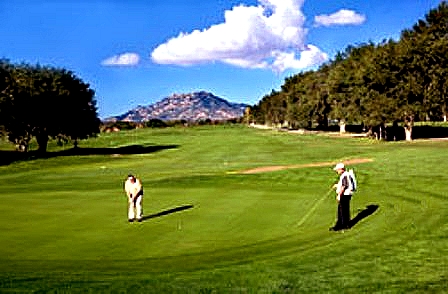The Buzz: You won’t find it listed among the Valley of the Sun’s prominent courses, but Apache Creek is an enjoyable layout with just enough challenges to keep you focused and its rates make it a good value play. Set in the far Southeast Valley in Apache Junction, and free of housing and other development, the course maneuvers through the desert with low-lying fairways, medium-to-large greens and minimal bunkering. There are two lakes and a large pond, which are connected by a narrow stream that brings strategy into play on several holes on the back nine. This is one of those courses that would work perfectly as the second round of your 36-hole binge.
Designed by Joe Alsip, the course is dotted with indigenous ironwood, mesquite and Palo Verde trees and offers generous fairways but some rugged transition areas between them. It also has an island green, several strategic doglegs, some nice mountain vistas and four sets of tees, ranging from 5,315 to 6,785 yards. The par-71 layout is rated at 71.3 with a slope of 123 from the back tees.
Highlights on the front nine are the fifth and sixth holes. No. 5, a 529-yard par 5, is a sharp dogleg left that plays into a prevailing wind with a lake along the right side of the fairway and a single Palo Verde tree in the middle of the fairway that always seems to get in the way. The sixth is a 145-yard par 3 to an island green in the middle of that same lake.
After the turn, No. 12 is another good par 3, at 153 yards, with a tee shot over a lake to a green with a bunker on the back that can make for a difficult sand shot back toward the water. A stream from that lake cuts across holes 13, 15 and 17 in menacing fashion. No. 15 is a double dogleg par 5 at 548 yards with the stream cutting across just in front of the green in the spirit of famed Rae’s Creek at Augusta National. The same is true at 17, where the stream crosses in front of the green and connects to a large pond near the left front corner of the green and end of the fairway.
The finishing hole can be a beast of a par 4 at 490 yards from the tips. You can shorten it considerably by cutting the corner on this severe dogleg left, but if you come up short of the fairway, an endless waste bunker awaits.
Apache Creek has an older, ranch-style clubhouse with a full golf shop, bar and grill and a western ambiance. Practice facilities include a generous driving range that has mobile shade and a misting canopy to help beat the summer heat, putting and chipping greens. Combine all of that with scenic views of the Superstition Mountains and Four Peaks, reasonable green fees and Internet specials, and it’s easy to see why this is a popular course among local golfers.

